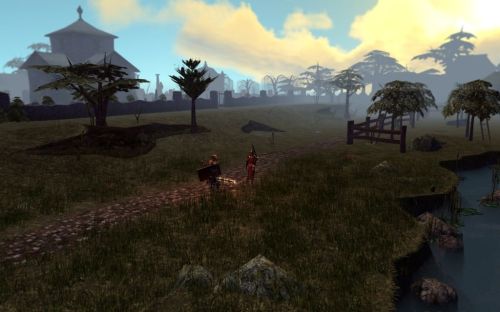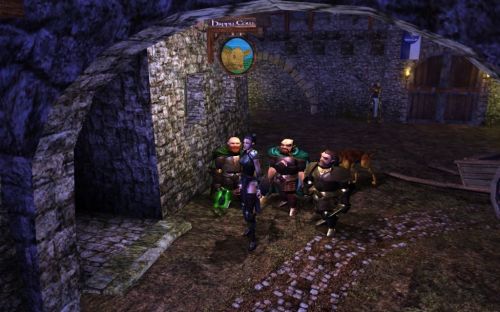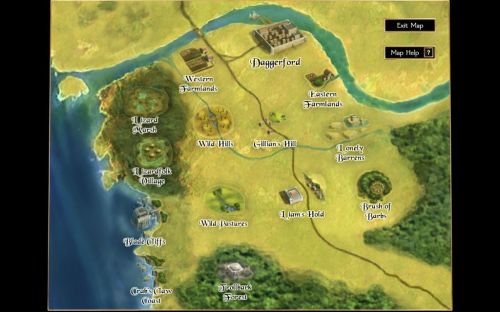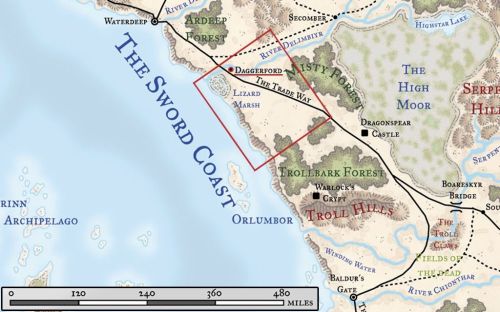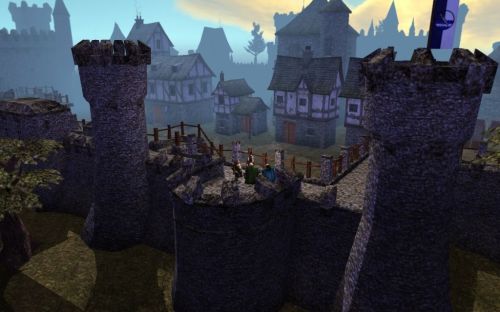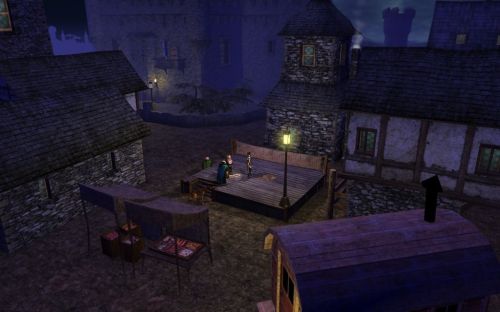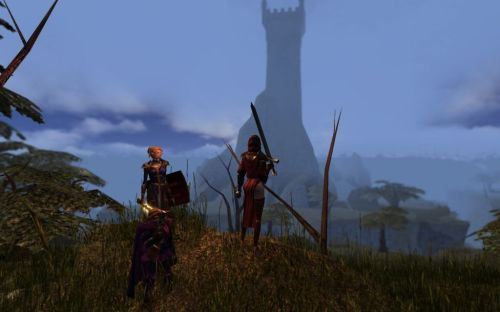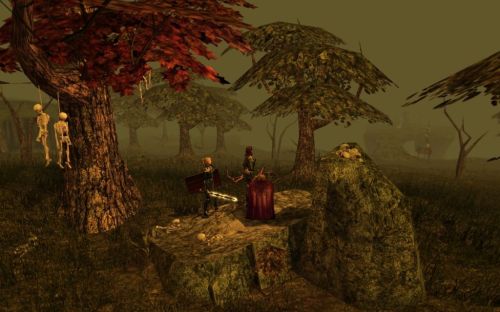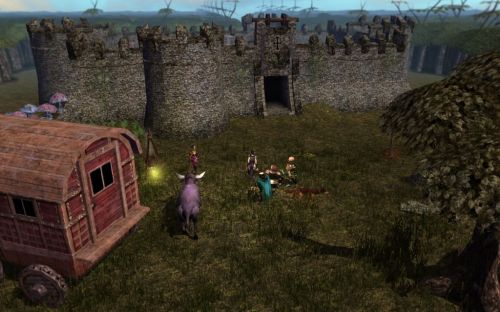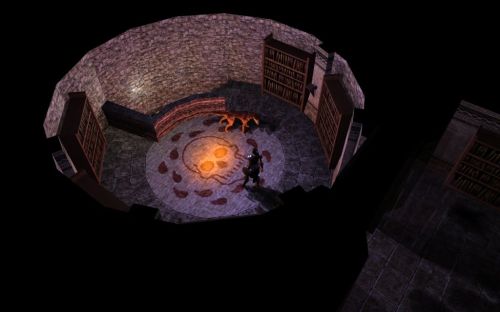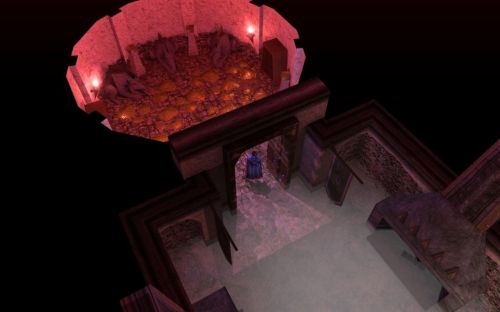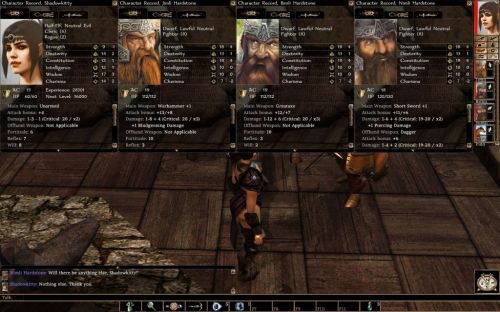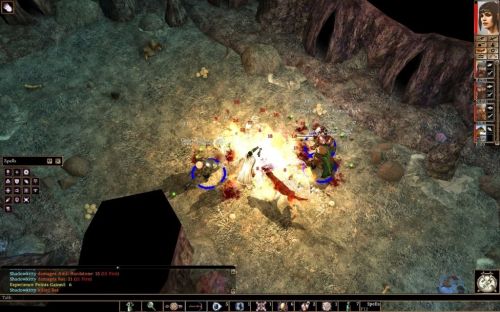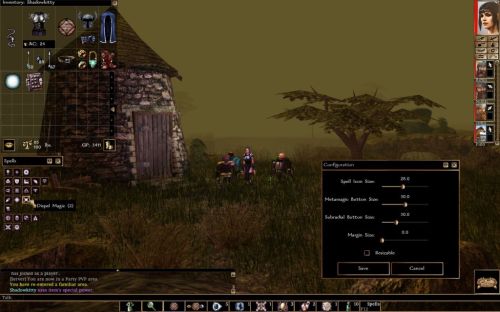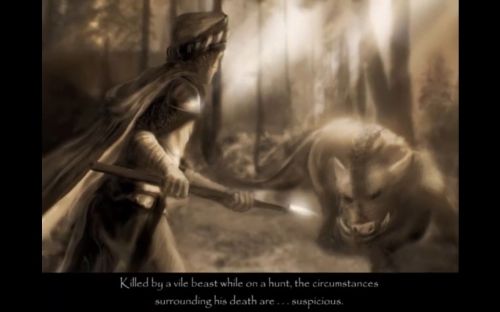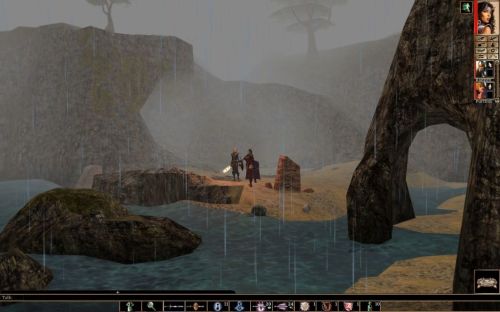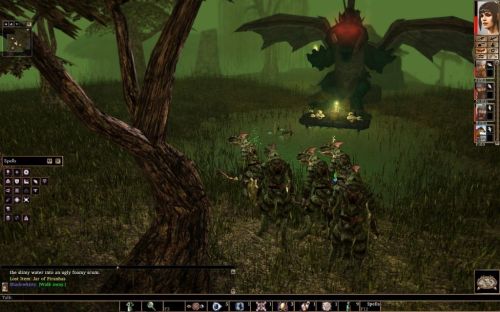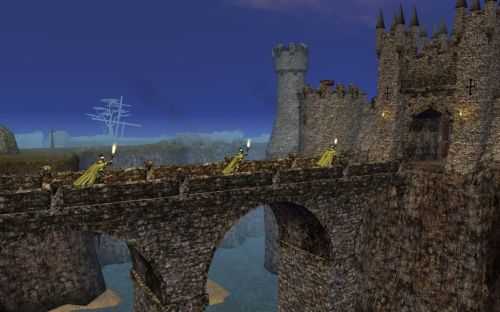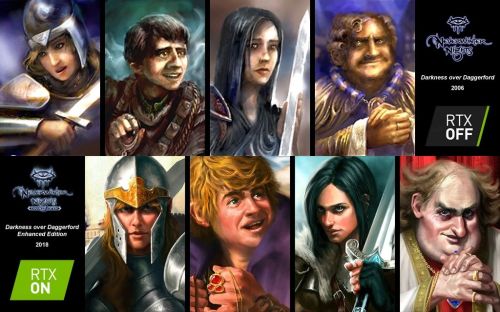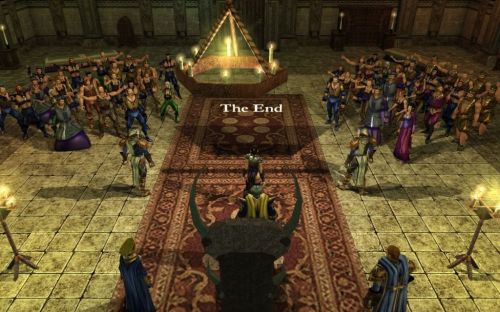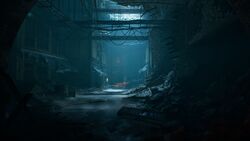RPG Codex Review: Neverwinter Nights – Darkness Over Daggerford
RPG Codex Review: Neverwinter Nights – Darkness Over Daggerford
Codex Review - posted by Infinitron on Sat 13 April 2024, 00:38:08
Tags: Beamdog; BioWare; Neverwinter Nights; Neverwinter Nights: Darkness over Daggerford; Ossian StudiosLast month, we published a review of Ossian Studios' Tyrants of the Moonsea module for Neverwinter Nights: Enhanced Edition by our resident Neverwinter Nights expert Gargaune. I'm happy to report that Gargaune decided to follow that up with a review of Ossian's other Enhanced Edition DLC module, the Baldur's Gate-ish adventure Neverwinter Nights: Darkness Over Daggerford. Unlike Tyrants of the Moonsea, the original free version of Darkness Over Daggerford was basically complete when it was released following the cancellation of the NWN premium module program back in 2006. Its 2018 Enhanced Edition rerelease offered mainly audio/visual improvements and bugfixes, which normally wouldn't be significant enough to merit a review. However, since we never actually published a review of the original module, it's a fine opportunity to finally give it the attention it deserves. Without further ado:
Read the full article: RPG Codex Review: Neverwinter Nights – Darkness Over Daggerford
Per Ossian themselves, their ambition for Darkness over Daggerford was to recreate a Baldur’s Gate-like experience, referring to the BioWare title’s open-world structure in particular. And to that end, Miranda’s little studio delivered a feature that was sorely lacking in the original release and one that remains among NWN’s standout post-launch additions – a true and proper world map! Indeed, DoD is the most “open world” NWN module I’ve played to date and Ossian genuinely succeeded in recapturing that original BG feeling of roaming the countryside looking for trouble. After being set loose from Daggerford itself, situated in the northern part of the map, you’re free to explore a large, semi-contiguous region stretching out to the south, along the Trade Way heading to Baldur’s Gate. The world map in DoD isn’t just a nice visual flourish on your destination list like in the later TotM, but consistently involves discovery – e.g. to reach the Wild Hills for the first time, you’ll have to travel in its direction from the Western Farmlands, Gillian’s Hill, or the Wild Pastures, but you can’t just hop over from the Eastern Farmlands unless you’ve already visited the Wild Hills before. Quest destinations will reveal some major locations on the map, while others you’ll discover as proximate to your current location.
Daggerford isn’t the only civilized settlement in this area either, as you’ll also visit the hamlets of Gillian’s Hill and Liam’s Hold, while veering off from the Trade Way to either the East or the West will reveal farmlands, wilderness and the odd surprise. As a nice touch, the developers also took a moment to make Daggerford and Liam’s Hold seem more alive with ambient NPCs who shut nearby open doors and clear the streets after dark, replaced by torch-bearing watchmen, though it’s a purely cosmetic affair and won’t afford any special gameplay opportunities. Each map location has its own quests and encounters, and the designers crisscrossed objectives over the world map efficiently, such that you can expect to be doing some regular back-and-forth and getting to know Daggerford’s environs quite well. Areas don’t respawn, but travelling from one to the other has a chance of triggering one of a number of repeatable random encounters which also net a little bonus XP. Additionally, DoD is the originator of the fatigue system I mentioned in my TotM review: going for more than 36 in-game hours without resting will afflict you and your henchmen with a -1 to all Ability scores, unless you’re immune to Ability Drain, and have characters play a tired animation (which will bug you when you’re trying to swap gear while exhausted). DoD’s map scope and travel times are (unsurprisingly) well suited to seeing this mechanic in action with some regularity, particularly when you’re first unlocking locations on the map, though leaving from a random encounter area results in an auto-rest. As became the standard post-HotU, resting advances the clock by 8 hours and doing it in dangerous locations has a chance of spawning a hostile encounter right on top of you, so you have a theoretical incentive to make use of your room at the Happy Cow or other local accommodations.
But if everything I’ve said so far sounds pretty good, it’s time to change gears for a moment because DoD doesn’t put its best foot forward. Whereas the open world has plenty to get excited about, you’ll have to clear Daggerford before you get to it… While none of its content is bad, it’s nonetheless a rather drab affair and DoD’s weakest stage by far. Along the main plot, you’ll be chasing up some leads for Amara and you’re also given ample opportunity to load up on side quests that you’ll be tackling later on, once you’re actually free to leave town, but it just drags on for a bit too long. The town of Daggerford consists of roughly two rows of buildings in a rectangular courtyard, opposite the ducal palace, and a small, separate docks area, and it’s just not a very inspiring locale. There’s enough quest content to keep you going and even the odd unmarked opportunity, but you’ll quickly find yourself pining for more even on your first time, let alone replays.
Mercifully, once the plot progresses and you’re free to come and go, you’ll be introduced to the world map and find that DoD’s various areas have a solid amount of thematic and quest variety. The thrill of exploration should soon follow and it’s hard to overstate just how different an experience it is from NWN’s mainstream linear modules like HotU, let alone the drudgery of its original campaign. From peaceful farmlands to a besieged castle perched atop the Blade Cliffs, from a swampy Lizardfolk village to a wizard’s tower looming over an impassable chasm, “I wonder what’s going on over there” is a recurring thought for the rambling player. Sometimes it’s the regular adventuring fare, others it’s surprisingly creative, such as the aforementioned Lizardfolk village, which you’ll be infiltrating disguised as a scaly critter yourself, courtesy of a hag with a chip on her shoulder. Another quest will have you undertake a quaint little investigation at a wake with your choice of amusing resolutions. As for the looming wizard’s tower I brought up, I suppose it shouldn’t surprise you to learn it’s puzzles all the way to the top, and not the lean variety, get ready to break out some pen and paper! There are puzzles and secrets in a few other quests and locations, but this is clearly where that one guy on the dev team went “okay, my turn to mess with the player!” And all of these examples are optional side content, the sort you pick up through organic exploration or get brought to your attention under no obligation to complete.
[...] When Beamdog first announced they were publishing the EE version of Darkness over Daggerford, I was fresh off the PM edition a couple of weeks prior. It was early days for NWN’s Enhanced Edition and the big player-side improvements were still to come, but I was chuffed enough with Ossian's work and their sporting decision to release their cancelled project all those years ago that it yanked me right off that fence.
Darkness over Daggerford’s EE treatment added a coat of QA and audio/visual polish to complete the project and it does that very well, bringing it up to a full and proper commercial standard. That said, we have to be fair and recognise some missed opportunities as well. I grant that developing whole new quests and levels might’ve been costly propositions for what was already a complete module, but restoring that cut dragon attack to the stronghold questline or fleshing out the henchmen situation could’ve been some great and affordable ways to add value. I was also surprised that more comprehensive alignment reactivity wasn’t added, though clearly that was a design oversight rather than a budget constraint, since Ossian did undertake an extensive review of conversations and associated scripting. Darkness over Daggerford was already bigger and better rounded than most PMs, indeed it’d have likely been the best of the bunch had Atari given it its commercial release, but there was still room to grow. The final package is good value notwithstanding, but the EE revision comes across as a more modest commitment than Beamdog’s and Ossian’s later collaboration on Tyrants of the Moonsea and the focus seems to have been to fill in the PM’s blanks in quality control and production value rather than revisit and expand its development.
Bottom line, DoD caters to some RPG fans more than to others. If you're looking for a dungeon crawl, this isn't the module for you. If you're in it for a grand, sombre plot, it ain't that either. But if you want something to recapture that Baldur's Gate-like sense of exploration, of roaming the countryside in search of adventure and curiosities, it doesn’t get much better than Darkness over Daggerford for NWN or many other contenders. It’s a charming and lively open-world adventure, which is equally true for the new EE revision with its polished production values (for sale on GOG, Steam, or directly from Beamdog) as it is for the old PM release (available at the Neverwinter Vault). Either package is well worth checking out if that speaks to you, but the EE version will certainly yield the best experience if it’s within your budget, and if one good turn deserves another, Ossian absolutely did NWN fans a solid back in the day.
Daggerford isn’t the only civilized settlement in this area either, as you’ll also visit the hamlets of Gillian’s Hill and Liam’s Hold, while veering off from the Trade Way to either the East or the West will reveal farmlands, wilderness and the odd surprise. As a nice touch, the developers also took a moment to make Daggerford and Liam’s Hold seem more alive with ambient NPCs who shut nearby open doors and clear the streets after dark, replaced by torch-bearing watchmen, though it’s a purely cosmetic affair and won’t afford any special gameplay opportunities. Each map location has its own quests and encounters, and the designers crisscrossed objectives over the world map efficiently, such that you can expect to be doing some regular back-and-forth and getting to know Daggerford’s environs quite well. Areas don’t respawn, but travelling from one to the other has a chance of triggering one of a number of repeatable random encounters which also net a little bonus XP. Additionally, DoD is the originator of the fatigue system I mentioned in my TotM review: going for more than 36 in-game hours without resting will afflict you and your henchmen with a -1 to all Ability scores, unless you’re immune to Ability Drain, and have characters play a tired animation (which will bug you when you’re trying to swap gear while exhausted). DoD’s map scope and travel times are (unsurprisingly) well suited to seeing this mechanic in action with some regularity, particularly when you’re first unlocking locations on the map, though leaving from a random encounter area results in an auto-rest. As became the standard post-HotU, resting advances the clock by 8 hours and doing it in dangerous locations has a chance of spawning a hostile encounter right on top of you, so you have a theoretical incentive to make use of your room at the Happy Cow or other local accommodations.
But if everything I’ve said so far sounds pretty good, it’s time to change gears for a moment because DoD doesn’t put its best foot forward. Whereas the open world has plenty to get excited about, you’ll have to clear Daggerford before you get to it… While none of its content is bad, it’s nonetheless a rather drab affair and DoD’s weakest stage by far. Along the main plot, you’ll be chasing up some leads for Amara and you’re also given ample opportunity to load up on side quests that you’ll be tackling later on, once you’re actually free to leave town, but it just drags on for a bit too long. The town of Daggerford consists of roughly two rows of buildings in a rectangular courtyard, opposite the ducal palace, and a small, separate docks area, and it’s just not a very inspiring locale. There’s enough quest content to keep you going and even the odd unmarked opportunity, but you’ll quickly find yourself pining for more even on your first time, let alone replays.
Mercifully, once the plot progresses and you’re free to come and go, you’ll be introduced to the world map and find that DoD’s various areas have a solid amount of thematic and quest variety. The thrill of exploration should soon follow and it’s hard to overstate just how different an experience it is from NWN’s mainstream linear modules like HotU, let alone the drudgery of its original campaign. From peaceful farmlands to a besieged castle perched atop the Blade Cliffs, from a swampy Lizardfolk village to a wizard’s tower looming over an impassable chasm, “I wonder what’s going on over there” is a recurring thought for the rambling player. Sometimes it’s the regular adventuring fare, others it’s surprisingly creative, such as the aforementioned Lizardfolk village, which you’ll be infiltrating disguised as a scaly critter yourself, courtesy of a hag with a chip on her shoulder. Another quest will have you undertake a quaint little investigation at a wake with your choice of amusing resolutions. As for the looming wizard’s tower I brought up, I suppose it shouldn’t surprise you to learn it’s puzzles all the way to the top, and not the lean variety, get ready to break out some pen and paper! There are puzzles and secrets in a few other quests and locations, but this is clearly where that one guy on the dev team went “okay, my turn to mess with the player!” And all of these examples are optional side content, the sort you pick up through organic exploration or get brought to your attention under no obligation to complete.
[...] When Beamdog first announced they were publishing the EE version of Darkness over Daggerford, I was fresh off the PM edition a couple of weeks prior. It was early days for NWN’s Enhanced Edition and the big player-side improvements were still to come, but I was chuffed enough with Ossian's work and their sporting decision to release their cancelled project all those years ago that it yanked me right off that fence.
Darkness over Daggerford’s EE treatment added a coat of QA and audio/visual polish to complete the project and it does that very well, bringing it up to a full and proper commercial standard. That said, we have to be fair and recognise some missed opportunities as well. I grant that developing whole new quests and levels might’ve been costly propositions for what was already a complete module, but restoring that cut dragon attack to the stronghold questline or fleshing out the henchmen situation could’ve been some great and affordable ways to add value. I was also surprised that more comprehensive alignment reactivity wasn’t added, though clearly that was a design oversight rather than a budget constraint, since Ossian did undertake an extensive review of conversations and associated scripting. Darkness over Daggerford was already bigger and better rounded than most PMs, indeed it’d have likely been the best of the bunch had Atari given it its commercial release, but there was still room to grow. The final package is good value notwithstanding, but the EE revision comes across as a more modest commitment than Beamdog’s and Ossian’s later collaboration on Tyrants of the Moonsea and the focus seems to have been to fill in the PM’s blanks in quality control and production value rather than revisit and expand its development.
Bottom line, DoD caters to some RPG fans more than to others. If you're looking for a dungeon crawl, this isn't the module for you. If you're in it for a grand, sombre plot, it ain't that either. But if you want something to recapture that Baldur's Gate-like sense of exploration, of roaming the countryside in search of adventure and curiosities, it doesn’t get much better than Darkness over Daggerford for NWN or many other contenders. It’s a charming and lively open-world adventure, which is equally true for the new EE revision with its polished production values (for sale on GOG, Steam, or directly from Beamdog) as it is for the old PM release (available at the Neverwinter Vault). Either package is well worth checking out if that speaks to you, but the EE version will certainly yield the best experience if it’s within your budget, and if one good turn deserves another, Ossian absolutely did NWN fans a solid back in the day.
Read the full article: RPG Codex Review: Neverwinter Nights – Darkness Over Daggerford
[Review by Gargaune]
In our previous episode, I reviewed Tyrants of the Moonsea and proclaimed it “the best piece of official content for Neverwinter Nights”, and now I thought we’d also take a look at Darkness over Daggerford, the Enhanced Edition’s first expansion pack, and see how that stacks up. After all, it’s got a long history of being unfairly passed over and I wasn’t about to add to that ignominy.
Hope, betrayal and redemption! If you think I’m about to introduce Darkness over Daggerford’s plot, you’re getting ahead of yourself, I’m talking about the story of its making. Atari’s Premium Modules program was an ambitious initiative and a natural fit for the Aurora Toolset’s supreme content-building accessibility – in a time before the term “DLC”, when Bethesda’s idea of added value was horse armour, BioWare and their publisher offered something far better in the form of “mini” NWN expansions. While this did yield a number of interesting add-ons, both WotC-licensed like Pirates of the Sword Coast, or in homebrew settings such as Kingmaker’s, there was a great deal of confusion behind the operation and mass online commerce was only starting up, so it eventually – and unexpectedly – came to an end in 2006. Ossian Studios, headed by former BioWare Throne of Bhaal and Neverwinter Nights assistant/associate producer Alan Miranda, were wrapping up DoD when the banhammer fell. Atari would yet again flip-flop and allow another PM, Wyvern Crown of Cormyr, a commercial release after all, but no such grace was extended to poor DoD and Ossian decided to share it with the fan community for free on the Neverwinter Vault.
Years went by, Ossian returned to Atari to publish the Neverwinter Nights 2 expansion Mysteries of Westgate in 2009, but DoD’s fate seemed sealed, its highest accolade an IGF Best RPG Mod award in 2007. Until one sunny morning (maybe, I dunno) when the NWN license found its way back into the hands of Trent Oster, the game’s original director at BioWare and founder of Beamdog. With that change in management, Ossian finally got their second chance at the title and after a round of bugfixes and finishing touches, Darkness over Daggerford became Neverwinter Nights: Enhanced Edition’s first expansion pack a couple of months following its March 2018 release. And, much to their credit, Beamdog published it without removing the cancelled PM edition of DoD from the Vault.
But what of it? Should you, the prestigious NWN enthusiast, play Darkness over Daggerford? Well, I’ve got the answer if you’ve got the time. Since the playable content of the adventure remains much the same between the original, cancelled Premium Module and the new Enhanced Edition expansion, with most changes relegated to QA and audio/visual trimmings, I’ll be reviewing the EE version as the finished article and delving into the differences more towards the end, when we cover production value.
Years went by, Ossian returned to Atari to publish the Neverwinter Nights 2 expansion Mysteries of Westgate in 2009, but DoD’s fate seemed sealed, its highest accolade an IGF Best RPG Mod award in 2007. Until one sunny morning (maybe, I dunno) when the NWN license found its way back into the hands of Trent Oster, the game’s original director at BioWare and founder of Beamdog. With that change in management, Ossian finally got their second chance at the title and after a round of bugfixes and finishing touches, Darkness over Daggerford became Neverwinter Nights: Enhanced Edition’s first expansion pack a couple of months following its March 2018 release. And, much to their credit, Beamdog published it without removing the cancelled PM edition of DoD from the Vault.
But what of it? Should you, the prestigious NWN enthusiast, play Darkness over Daggerford? Well, I’ve got the answer if you’ve got the time. Since the playable content of the adventure remains much the same between the original, cancelled Premium Module and the new Enhanced Edition expansion, with most changes relegated to QA and audio/visual trimmings, I’ll be reviewing the EE version as the finished article and delving into the differences more towards the end, when we cover production value.
“The outlook is golden!”
You begin in what’s ostensibly the inside of a merchant wagon, with a little halfling pleading for your attention. Why, exactly, the man who’s introduced as your employer takes such a grovelling posture towards a hired guard is unclear, but you’re informed that the Daggerford-bound caravan is soon to break camp and your friend and companion, a woman by the name of Talarenne, is waiting for you outside. As your humble boss leaves, you’re afforded the opportunity to prepare your character and have a little kip before stepping out to enjoy some expository dialogue with Talarenne, establishing how you’re good friends and have saved each other from many a nest of Gundarks. And then – poof! – Talarenne is snatched away by a mysterious spell! And bandits are attacking the convoy! Oh, dear! Anyway, after you’ve teabagged their corpses, you’re introduced to one Amara Leontyne (fellow teabagger), who bears a passing resemblance to poor Talarenne and suggests you meet up in town to see if you can figure out what happened to your chum.
Reputed to be a prosperous little town along the Delimbiyr, Daggerford has nonetheless fallen on hard times. Its beloved Duke, Pwyll Greatshout, has tragically (and suspiciously!) passed in a recent hunting accident, and Matagar Bugo, wealthy merchant and self-titled “Baron of Daggerford”, has risen to power in his stead. Yet despite Bugo’s promise to develop Daggerford into a great metropolis to rival the City of Splendors just a ways to the north, many in the town’s outlying regions have begun feeling the pinch of cattle rustling and bandit raids, the latter which you can attest to yourself. There is something afoot between Daggerford’s stone walls, and Amara wants your help to get to the root of it, in exchange for which she promises to aid with tracking down Talarenne. Her main task for you at this point would be to help the farmers who’ve come to get assistance with their vanishing bovines, but that’s more of a long term goal because Daggerford has been locked down for the time and you’ll have other busywork before the gates open again.
Amara herself won’t join you in your adventures, she’s more the managerial type, but you’ll quickly run into two other characters who’ve arrived with your same caravan, the human sellsword Raegen Brunegar and the gnome Purfbin Doogrick, “professional treasure hunter.” You’ll find the former at the Happy Cow Tavern, which will also serve as your home during the first part of the adventure, and the latter skulking about the Black Stone Inn, which ironically has no rooms to rent. These two are the only permanent henchmen you get in DoD and though they can both join you at once, they unfortunately have little to contribute beyond rounding your party with a warrior and a rogue, as you may need. They may have the odd quip or interjection in dialogue, but they don’t really have much of a backstory or personal content to explore. You’ll get a third henchman for a late-game segment and that one’s got a bit more chatter and involvement, but for the bulk of the adventure, Raegen and Purfbin will be your mostly silent partners.
The writing in general is a bit on the cheerful side. You actually get one quest delving into the literally cutthroat dairy business. Another has you unravel a most fowl curse – no, that’s not a misspelling. Characters tend to be simplistic, one-note constructions and dialogue often has that tongue-in-cheek tabletop tone – not the tired 2020s “OMG quirky!” but certainly reminiscent of the original Baldur’s Gate’s tomfoolery at times. Which isn’t to say the material never gets dark (see Xatuum’s in-game journal for a counterpoint), but the narrative presentation overall has a somewhat more comedic and superficial bent than your average NWN expansion – it’s more Pirates of the Sword Coast than Hordes of the Underdark. Or, to put it more poignantly, more Baldur’s Gate than Baldur’s Gate II. Your mileage may vary, but I prefer BG2’s mannerisms.
Amara herself won’t join you in your adventures, she’s more the managerial type, but you’ll quickly run into two other characters who’ve arrived with your same caravan, the human sellsword Raegen Brunegar and the gnome Purfbin Doogrick, “professional treasure hunter.” You’ll find the former at the Happy Cow Tavern, which will also serve as your home during the first part of the adventure, and the latter skulking about the Black Stone Inn, which ironically has no rooms to rent. These two are the only permanent henchmen you get in DoD and though they can both join you at once, they unfortunately have little to contribute beyond rounding your party with a warrior and a rogue, as you may need. They may have the odd quip or interjection in dialogue, but they don’t really have much of a backstory or personal content to explore. You’ll get a third henchman for a late-game segment and that one’s got a bit more chatter and involvement, but for the bulk of the adventure, Raegen and Purfbin will be your mostly silent partners.
The writing in general is a bit on the cheerful side. You actually get one quest delving into the literally cutthroat dairy business. Another has you unravel a most fowl curse – no, that’s not a misspelling. Characters tend to be simplistic, one-note constructions and dialogue often has that tongue-in-cheek tabletop tone – not the tired 2020s “OMG quirky!” but certainly reminiscent of the original Baldur’s Gate’s tomfoolery at times. Which isn’t to say the material never gets dark (see Xatuum’s in-game journal for a counterpoint), but the narrative presentation overall has a somewhat more comedic and superficial bent than your average NWN expansion – it’s more Pirates of the Sword Coast than Hordes of the Underdark. Or, to put it more poignantly, more Baldur’s Gate than Baldur’s Gate II. Your mileage may vary, but I prefer BG2’s mannerisms.
Farmlands & Dragons
I’ve got three DoD playthroughs under my belt, one of the cancelled PM distribution on the old Diamond Edition, and two of the new Enhanced Edition version. The adventure starts you off at level 8, automatically levelling up fresh characters, and I’d comfortably put a completionist run around the 25-hour mark, having finished at levels 13, 14 and 15 respectively. On the first, I’d left a major questline unattended and the last was significantly modded (we’ll get to that), so a level range of 8-14 is probably the safe bet.
Per Ossian themselves, their ambition for Darkness over Daggerford was to recreate a Baldur’s Gate-like experience, referring to the BioWare title’s open-world structure in particular. And to that end, Miranda’s little studio delivered a feature that was sorely lacking in the original release and one that remains among NWN’s standout post-launch additions – a true and proper world map! Indeed, DoD is the most “open world” NWN module I’ve played to date and Ossian genuinely succeeded in recapturing that original BG feeling of roaming the countryside looking for trouble. After being set loose from Daggerford itself, situated in the northern part of the map, you’re free to explore a large, semi-contiguous region stretching out to the south, along the Trade Way heading to Baldur’s Gate. The world map in DoD isn’t just a nice visual flourish on your destination list like in the later TotM, but consistently involves discovery – e.g. to reach the Wild Hills for the first time, you’ll have to travel in its direction from the Western Farmlands, Gillian’s Hill, or the Wild Pastures, but you can’t just hop over from the Eastern Farmlands unless you’ve already visited the Wild Hills before. Quest destinations will reveal some major locations on the map, while others you’ll discover as proximate to your current location.
Per Ossian themselves, their ambition for Darkness over Daggerford was to recreate a Baldur’s Gate-like experience, referring to the BioWare title’s open-world structure in particular. And to that end, Miranda’s little studio delivered a feature that was sorely lacking in the original release and one that remains among NWN’s standout post-launch additions – a true and proper world map! Indeed, DoD is the most “open world” NWN module I’ve played to date and Ossian genuinely succeeded in recapturing that original BG feeling of roaming the countryside looking for trouble. After being set loose from Daggerford itself, situated in the northern part of the map, you’re free to explore a large, semi-contiguous region stretching out to the south, along the Trade Way heading to Baldur’s Gate. The world map in DoD isn’t just a nice visual flourish on your destination list like in the later TotM, but consistently involves discovery – e.g. to reach the Wild Hills for the first time, you’ll have to travel in its direction from the Western Farmlands, Gillian’s Hill, or the Wild Pastures, but you can’t just hop over from the Eastern Farmlands unless you’ve already visited the Wild Hills before. Quest destinations will reveal some major locations on the map, while others you’ll discover as proximate to your current location.
Daggerford isn’t the only civilized settlement in this area either, as you’ll also visit the hamlets of Gillian’s Hill and Liam’s Hold, while veering off from the Trade Way to either the East or the West will reveal farmlands, wilderness and the odd surprise. As a nice touch, the developers also took a moment to make Daggerford and Liam’s Hold seem more alive with ambient NPCs who shut nearby open doors and clear the streets after dark, replaced by torch-bearing watchmen, though it’s a purely cosmetic affair and won’t afford any special gameplay opportunities. Each map location has its own quests and encounters, and the designers crisscrossed objectives over the world map efficiently, such that you can expect to be doing some regular back-and-forth and getting to know Daggerford’s environs quite well. Areas don’t respawn, but travelling from one to the other has a chance of triggering one of a number of repeatable random encounters which also net a little bonus XP. Additionally, DoD is the originator of the fatigue system I mentioned in my TotM review: going for more than 36 in-game hours without resting will afflict you and your henchmen with a -1 to all Ability scores, unless you’re immune to Ability Drain, and have characters play a tired animation (which will bug you when you’re trying to swap gear while exhausted). DoD’s map scope and travel times are (unsurprisingly) well suited to seeing this mechanic in action with some regularity, particularly when you’re first unlocking locations on the map, though leaving from a random encounter area results in an auto-rest. As became the standard post-HotU, resting advances the clock by 8 hours and doing it in dangerous locations has a chance of spawning a hostile encounter right on top of you, so you have a theoretical incentive to make use of your room at the Happy Cow or other local accommodations.
But if everything I’ve said so far sounds pretty good, it’s time to change gears for a moment because DoD doesn’t put its best foot forward. Whereas the open world has plenty to get excited about, you’ll have to clear Daggerford before you get to it… While none of its content is bad, it’s nonetheless a rather drab affair and DoD’s weakest stage by far. Along the main plot, you’ll be chasing up some leads for Amara and you’re also given ample opportunity to load up on side quests that you’ll be tackling later on, once you’re actually free to leave town, but it just drags on for a bit too long. The town of Daggerford consists of roughly two rows of buildings in a rectangular courtyard, opposite the ducal palace, and a small, separate docks area, and it’s just not a very inspiring locale. There’s enough quest content to keep you going and even the odd unmarked opportunity, but you’ll quickly find yourself pining for more even on your first time, let alone replays.
Mercifully, once the plot progresses and you’re free to come and go, you’ll be introduced to the world map and find that DoD’s various areas have a solid amount of thematic and quest variety. The thrill of exploration should soon follow and it’s hard to overstate just how different an experience it is from NWN’s mainstream linear modules like HotU, let alone the drudgery of its original campaign. From peaceful farmlands to a besieged castle perched atop the Blade Cliffs, from a swampy Lizardfolk village to a wizard’s tower looming over an impassable chasm, “I wonder what’s going on over there” is a recurring thought for the rambling player. Sometimes it’s the regular adventuring fare, others it’s surprisingly creative, such as the aforementioned Lizardfolk village, which you’ll be infiltrating disguised as a scaly critter yourself, courtesy of a hag with a chip on her shoulder. Another quest will have you undertake a quaint little investigation at a wake with your choice of amusing resolutions. As for the looming wizard’s tower I brought up, I suppose it shouldn’t surprise you to learn it’s puzzles all the way to the top, and not the lean variety, get ready to break out some pen and paper! There are puzzles and secrets in a few other quests and locations, but this is clearly where that one guy on the dev team went “okay, my turn to mess with the player!” And all of these examples are optional side content, the sort you pick up through organic exploration or get brought to your attention under no obligation to complete.
Mercifully, once the plot progresses and you’re free to come and go, you’ll be introduced to the world map and find that DoD’s various areas have a solid amount of thematic and quest variety. The thrill of exploration should soon follow and it’s hard to overstate just how different an experience it is from NWN’s mainstream linear modules like HotU, let alone the drudgery of its original campaign. From peaceful farmlands to a besieged castle perched atop the Blade Cliffs, from a swampy Lizardfolk village to a wizard’s tower looming over an impassable chasm, “I wonder what’s going on over there” is a recurring thought for the rambling player. Sometimes it’s the regular adventuring fare, others it’s surprisingly creative, such as the aforementioned Lizardfolk village, which you’ll be infiltrating disguised as a scaly critter yourself, courtesy of a hag with a chip on her shoulder. Another quest will have you undertake a quaint little investigation at a wake with your choice of amusing resolutions. As for the looming wizard’s tower I brought up, I suppose it shouldn’t surprise you to learn it’s puzzles all the way to the top, and not the lean variety, get ready to break out some pen and paper! There are puzzles and secrets in a few other quests and locations, but this is clearly where that one guy on the dev team went “okay, my turn to mess with the player!” And all of these examples are optional side content, the sort you pick up through organic exploration or get brought to your attention under no obligation to complete.
Which gives me an excellent opportunity to talk about another big feature in DoD, and this one’s not coming from Baldur’s Gate but Shadows of Amn… Soon after arriving in Liam’s Hold, you get your very own stronghold! Abandoned since around the Time of Troubles, this ominous former temple to Bhaal is handed over to your management after a trivial bouncer quest and will serve as your main base of operations for the lower part of the map. You even get to pick from a number of different setups for your new pad thanks to the interior decorator who conveniently arrives on-site (the Forgotten Realms has it all, folks). The upper level only has some moody lore and knick-knacks, but waiting for you in the basement is a boss encounter which may be dealt with immediately or as part of a quest… And treasure! Thoroughly hidden treasure! Reminiscent of BG once more (albeit probably unintentionally this time), DoD has just a couple of instances that are the 3D equivalent of pixel hunting.
Anyway, your stronghold serves as a safe resting spot in the southern part of the map and a place to deposit any stuff you don’t want to lug around. But there’s one more important function beside that and that’s the introduction of side quests! DoD has two ways of dispensing optional content – some you find yourself by wandering the countryside, others will find you once you’ve acquired your stronghold. The way the latter works is that every time you leave your stronghold, the game has a random chance of presenting you with a visitor to offer an available quest from its list. Some, like the siege in the Blade Cliffs, can do either, meaning that if you haven’t already acquired it on your own by the time the dice roll, the game will happily dump it on your doorstep and set it alight.
There was more intended for the stronghold, and in a 2006 interview for Sorcerer’s Place signed Taluntain and Chevalier, Miranda described plans to have another event where a dragon and its minions would lay siege to your little fortress, and how the low roof was built precisely to let you bombard the horde until the dragon swooped in… Sadly, this idea was cut due to time constraints and the only thing that rooftop access gives you now is a nice view. And it’s not the only cut content in DoD, as the same interview outlines how there were originally supposed to be more areas on the world map. This isn’t the end of the world since the module is already long enough to work as a full expansion, though it’s always sad to hear.
But I’ve got a bone to pick with something else that was said there, and that’s how the module’s final dungeon, the one that serves as the adventure’s point of no return, was apparently intended to be a massive, multi-level crawl that just “didn’t work as well towards the end of the game, so it was redesigned to be smaller and tighter.” While I balk at the idea that an end-game mega-dungeon had to be scaled back, I’m okay with the result because it’s still a genuinely cool stage with a handful of different levels, puzzles, special encounters and all that good stuff. No, what I’d like to know – and those who’ve read my TotM review will remember I mentioned DoD in this regard – is what happened to all the other dungeons? Because that end-game dungeon is the only one worthy of the title. Most of the rest are more like “interior spaces”, just one or two rooms with a matching number of encounters, like single locations out of NWN2’s Storm of Zehir playbook. Off the top of my head, I can only recall the castle in the Blade Cliffs and a goblin hideout also fitting a dungeon layout, but both were very basic. Another instance stuck in my mind were the crypts under Gillian’s Hill, a truly befuddling experience of ploughing through a bunch of downgraded zombies down a linear corridor that made me miss the OC’s Peninsula District. It’s just odd seeing such a core aspect overlooked in contrast to all the love and care that otherwise went into DoD and I know the original Baldur’s Gate didn’t shine in this regard prior to Tales of The Sword Coast, but you don’t have to pay homage to everything about it.
There was more intended for the stronghold, and in a 2006 interview for Sorcerer’s Place signed Taluntain and Chevalier, Miranda described plans to have another event where a dragon and its minions would lay siege to your little fortress, and how the low roof was built precisely to let you bombard the horde until the dragon swooped in… Sadly, this idea was cut due to time constraints and the only thing that rooftop access gives you now is a nice view. And it’s not the only cut content in DoD, as the same interview outlines how there were originally supposed to be more areas on the world map. This isn’t the end of the world since the module is already long enough to work as a full expansion, though it’s always sad to hear.
But I’ve got a bone to pick with something else that was said there, and that’s how the module’s final dungeon, the one that serves as the adventure’s point of no return, was apparently intended to be a massive, multi-level crawl that just “didn’t work as well towards the end of the game, so it was redesigned to be smaller and tighter.” While I balk at the idea that an end-game mega-dungeon had to be scaled back, I’m okay with the result because it’s still a genuinely cool stage with a handful of different levels, puzzles, special encounters and all that good stuff. No, what I’d like to know – and those who’ve read my TotM review will remember I mentioned DoD in this regard – is what happened to all the other dungeons? Because that end-game dungeon is the only one worthy of the title. Most of the rest are more like “interior spaces”, just one or two rooms with a matching number of encounters, like single locations out of NWN2’s Storm of Zehir playbook. Off the top of my head, I can only recall the castle in the Blade Cliffs and a goblin hideout also fitting a dungeon layout, but both were very basic. Another instance stuck in my mind were the crypts under Gillian’s Hill, a truly befuddling experience of ploughing through a bunch of downgraded zombies down a linear corridor that made me miss the OC’s Peninsula District. It’s just odd seeing such a core aspect overlooked in contrast to all the love and care that otherwise went into DoD and I know the original Baldur’s Gate didn’t shine in this regard prior to Tales of The Sword Coast, but you don’t have to pay homage to everything about it.
Another baffling oversight relates to alignment shifts, which is to say there aren’t any. Well, there are a couple I’ve encountered, but limited to very sparing quest setpieces, such as marrying a young woman to a vampire, which will provide a sizeable Evil bump to any PC or specifically make a Paladin immediately fall from his deity’s grace. What’s strange about this is that the entire module’s dialogue is already well written to support a more comprehensive, systematic approach to handling alignment. The words are there, it’s just the scripts that are missing and it’s once again similar to a more perfunctory part of BG’s instead of NWN’s more consistent use of reactive alignment. On the bright side, you will at least get a conversation skill check every once in a while.
Okay, so are we done with the quibbles? Well, no, I’ve got one more for you… It’s a bit easy. Playing on Hardcore D&D Rules wasn’t all that hardcore most of the time, despite the level range sitting in 3E’s balance sweet spot. The game does try to throw the occasional curveball at you, like this one lich here or that werewolf there, but those are exceptions to the rule. There was precisely one encounter that facerolled me repeatedly on my latest playthrough, and that was Xatuum, the Bhaalist boss under your stronghold. You’re not actually required to take him on then and there, you can go and deal with a quest to soften him up, but I got the itch… I was ready to give up and make a note to come back after gaining another level or two, since I was only around halfway through the game and short on items, but I figured I’d give it one more go and optimise gear distribution among party members. At last, carefully deploying, buffing and drawing on all my trinkets, I managed to drop him. Nice, QQ moar! But the bulk of DoD’s combat can be readily brute-forced and enemy variety isn’t fantastic, with humanoids and goblinoids taking front and centre across most maps.
However, if combat’s not particularly challenging, I’m happy to report that the economy does pick up a bit of the slack. While stores have different markups, they also possess unlimited funds and it’s not really them strangling your bank balance, it’s the drops – DoD’s a little stingy, in a good way, with monetary rewards and loot alike. Meanwhile, those same merchants offer some pretty superb gear for your level range, but at exorbitant prices relative to your coinpurse. Realistically speaking, you’re only going to be able to afford three, maybe four truly top-shelf items from their stores and, given the somewhat scarce drops, may have to opt for some mid-range options to fill your party’s vacant inventory slots. The selection of weapon drops is also restrained, maybe with the exception of Longswords, so don’t hesitate to buy a nice weapon if it fits your build. Now, I did get three pairs of Boots of Speed on my last go, two I found and one I purchased, but that’s an outlier, the game doesn’t otherwise drown you in phantasmagorical equipment and you shouldn’t be shocked if you’ve still got a spare ring slot or two among your henchmen by the time you head into the last dungeon. You’ll also get some special utility loot, various magical doodads with bespoke spell abilities, but they don’t grow on trees.
Okay, so are we done with the quibbles? Well, no, I’ve got one more for you… It’s a bit easy. Playing on Hardcore D&D Rules wasn’t all that hardcore most of the time, despite the level range sitting in 3E’s balance sweet spot. The game does try to throw the occasional curveball at you, like this one lich here or that werewolf there, but those are exceptions to the rule. There was precisely one encounter that facerolled me repeatedly on my latest playthrough, and that was Xatuum, the Bhaalist boss under your stronghold. You’re not actually required to take him on then and there, you can go and deal with a quest to soften him up, but I got the itch… I was ready to give up and make a note to come back after gaining another level or two, since I was only around halfway through the game and short on items, but I figured I’d give it one more go and optimise gear distribution among party members. At last, carefully deploying, buffing and drawing on all my trinkets, I managed to drop him. Nice, QQ moar! But the bulk of DoD’s combat can be readily brute-forced and enemy variety isn’t fantastic, with humanoids and goblinoids taking front and centre across most maps.
However, if combat’s not particularly challenging, I’m happy to report that the economy does pick up a bit of the slack. While stores have different markups, they also possess unlimited funds and it’s not really them strangling your bank balance, it’s the drops – DoD’s a little stingy, in a good way, with monetary rewards and loot alike. Meanwhile, those same merchants offer some pretty superb gear for your level range, but at exorbitant prices relative to your coinpurse. Realistically speaking, you’re only going to be able to afford three, maybe four truly top-shelf items from their stores and, given the somewhat scarce drops, may have to opt for some mid-range options to fill your party’s vacant inventory slots. The selection of weapon drops is also restrained, maybe with the exception of Longswords, so don’t hesitate to buy a nice weapon if it fits your build. Now, I did get three pairs of Boots of Speed on my last go, two I found and one I purchased, but that’s an outlier, the game doesn’t otherwise drown you in phantasmagorical equipment and you shouldn’t be shocked if you’ve still got a spare ring slot or two among your henchmen by the time you head into the last dungeon. You’ll also get some special utility loot, various magical doodads with bespoke spell abilities, but they don’t grow on trees.
Mods will…
I would like to break form and talk about mods for a minute. Because while they’re not required, I do think there’s a golden opportunity here… I used my third go through DoD as a test bed for the OHS Henchman System, an old but extremely sophisticated mod that lets you basically roll a full custom party by importing local PCs to act as your henchmen in a module. And I’m very happy I did because it proved a wonderful match – DoD’s own two henchmen are very barebones so you miss nothing by replacing them, and the adventure lets you establish a home base very early in Daggerford’s Happy Cow Tavern before giving you a big, open world to explore at your leisure. I did further wreck the balance by running a party of four instead of the vanilla three, but I was testing things and if you’d like to follow suit, I’d definitely suggest you import no more than two OHS henchmen to replace the default ones (note that my prior observations on difficulty stand, they were formed off the two prior, unmodded playthroughs). It’s not perfect, there’s the odd bug (like OHS henchmen not automatically disengaging Search/Stealth when you do), but it’s a great new experience for NWN.
One important warning if you go with OHS, though – you’ll likely encounter a bug at the end of the Lizardfolk quest when the hag removes your party’s polymorph but Link Boy goes invisible and non-interactive. The simplest fix is the CCOHEE mod (for cosmetic character customisation): select Link Boy from its Change Target list and change his Appearance to anything, then you’ll be able to change it again via his regular dialogue. Another minor caveat is that your OHS party will spawn with you everywhere you go, which will trivialise one side quest where you’re supposed to be separated. Here you could just temporarily discard them outside (chat “OHDA”, see the manual) or simply order Stand Your Ground while you navigate the challenge yourself.
Aside from that, I’ll once again remind everyone that Neverwinter Nights: Enhanced Edition now includes a hidden advanced Party Controls feature that allows you to select any one or more party members and give them precise instructions to “move there” or “attack that.” Enable it by opening \Documents\Neverwinter Nights\settings.tml in a text editor and change the value of player-party-control to true. In-game, select party members by Ctrl+left clicking them or their portraits or hold Ctrl and drag a marquee selection, then Shift + left click their target foe or destination.
Aside from that, I’ll once again remind everyone that Neverwinter Nights: Enhanced Edition now includes a hidden advanced Party Controls feature that allows you to select any one or more party members and give them precise instructions to “move there” or “attack that.” Enable it by opening \Documents\Neverwinter Nights\settings.tml in a text editor and change the value of player-party-control to true. In-game, select party members by Ctrl+left clicking them or their portraits or hold Ctrl and drag a marquee selection, then Shift + left click their target foe or destination.
Finally, armed with custom henchmen you can point at enemies, spellcasters may also enjoy the NUI Spell Widget mod, which is basically a backport of NWN2’s superb Quickcast feature to NWN EE. It needs to be initialised from console and it’s not entirely bug-free (e.g. it won’t automatically interrupt your attack action and available slots don’t correctly decrement on interrupted spells), but it’s a wonderful QoL improvement for magic-users.
Squeaky wheel gets the kick?
The adventure opens with a cinematic sequence in classic style, composed of shifting 2D illustrations with a helpful narrator who catches us up on Daggerford’s latest tribulations. This is the exact same cinematic intro that played at the beginning of the old PM edition, but scaled up for modern displays and given a new voiceover narration, which is indeed an improvement over the original rendition. The illustrations themselves, however, aren’t jaw-dropping and show that hazy speedpainting quality indicative of budget constraints.
Now let me clarify something here, because for a PM, a bespoke illustrated intro was absolutely going above and beyond! Pirates of the Sword Coast didn’t get one. Wyvern Crown of Cormyr didn’t get one either. But Darkness over Daggerford, the one robbed of its release, did, and Ossian should be commended for it. At the same time, for an EE expansion pack – which is rather how this release was positioned – it’s sufficient but it won’t get me waxing poetic either. Again I have to compare it to either the second EE expansion, Tyrants of the Moonsea, or the original BioWare campaigns, and in both cases the artwork was more impressive. Giving these illustrations a spitshine for the EE wouldn’t have hurt its presentation or the piggybank.
Another peculiar EE version oversight in the same vein is the world map itself, which you’ve seen earlier in this article. It’s a nice map, fit for purpose, the area icons blend in, but it’s also decidedly low-resolution and looks slightly out of focus by 2018 standards. At least smacking it a couple of times with the enhancement stick should’ve been an obvious move, the world map system’s a prominent selling point for the module, but it wasn’t to be.
Another peculiar EE version oversight in the same vein is the world map itself, which you’ve seen earlier in this article. It’s a nice map, fit for purpose, the area icons blend in, but it’s also decidedly low-resolution and looks slightly out of focus by 2018 standards. At least smacking it a couple of times with the enhancement stick should’ve been an obvious move, the world map system’s a prominent selling point for the module, but it wasn’t to be.
Anyway, once wandering the region, the majority of the outdoors areas are built on just the one tileset, “Castle Exterior, Rural” (formerly “TNO: Exterior” in the DE distribution). To its credit, this was one of the first “mega-tilesets” the NWN community came up with, featuring a wide spectrum of customisation and applicability suitable for everything from fortified towns to small villages and wilderness areas. Indeed, different configurations mean that you won’t confuse the Brush of Barbs with its dense woods for the craggy Wild Hills, or the fetid Lizard Marsh for Crab Claw Coast, where tall cliffs plunge into narrow shoals. Though cut from the same cloth, the town of Daggerford is also visibly distinct from Liam’s Hold. It makes sense in a way that a contiguous countryside stretching out no more than two hundred miles south of Daggerford (at least on the WotC map, the in-game travel times are too short for that) would keep to a visual throughline, but while this was a new and exciting tileset in 2006, longtime NWN fans will have probably seen most it has to offer by now. The interiors are more varied, naturally, and will also feature the odd location on new tileset material from the same package, but as I’ve explained, they’re not mainstays in the adventure. Decoration usage is apt, also aided by some new assets like the Lizardfolk tents or placeable water objects, and the lighting’s competent albeit not as bold as in the later TotM. In usual fashion, the main plot and various side quests will make use of in-engine cinematic sequences to deliver some story beats, with the EE boasting some fixes to angles and camera placement.
The summary on visuals is that it’s a nice looking NWN module, certainly prettier than the stock content BioWare had put out, but it’s also nothing revolutionary by EE standards today. And in this regard, the EE and PM versions of DoD are effectively the same, though, to be honest, there wasn’t much to be done or particularly in need of attention to begin with.
What did get a fresh coat of paint in the EE are the key character portraits, NPCs like your henchmen or Amara or Matagar Bugo. The PM iteration also had portraits for them, but they were – no offense to the artist – the sort of thing a family man sees pinned to his fridge, whereas the new ones are professional grade material. Poor Talarenne, with her five minutes of screen time, didn’t even get one in the old PM edition and had to settle for a standard portrait… Well, even she’s got a spiffy mugshot all of her own now.
What did get a fresh coat of paint in the EE are the key character portraits, NPCs like your henchmen or Amara or Matagar Bugo. The PM iteration also had portraits for them, but they were – no offense to the artist – the sort of thing a family man sees pinned to his fridge, whereas the new ones are professional grade material. Poor Talarenne, with her five minutes of screen time, didn’t even get one in the old PM edition and had to settle for a standard portrait… Well, even she’s got a spiffy mugshot all of her own now.
Another EE upgrade over the PM edition concerns the module’s audio. Firstly, music – the old release already boasted five exclusive tracks by David John, to which the 2018 revision added twelve more pieces by Mark Braga. Between them, DoD now has its own varied score for every mood and location, from high adventure along the Blade Cliffs, to sleepy rural settlements or Bhaalspawn-reminiscent dungeons, and even flirting with Sigil’s bizarrerie alongside the Lizardfolk. It’s all technically solid and artistically fitting (with a personal exception for the Chateau Elite’s tune, which did not endear the place to me), but restricted to exploration themes, combat tracks are classic NWN material.
The second part is, of course, voiceovers, which the PM had none of, unless you count the cinematic narration at the beginning. With the EE, Ossian have finally had the opportunity to record a suitable complement of dialogue, covering the main cast and various supporting roles to a proper extent for an official bit of content. The quality can get a little uneven for some of the smaller parts, however – for example, while a main player like Amara is great throughout, Daggerford’s Captain Frederick’s delivery and recording sound like a volunteer contribution. In general, DoD’s VOs are fine, but the odd lapse can stand out here and there.
But when it comes to changes from the cancelled PM distribution to the EE release, it’s QA that’s gotten the most work. While all the game’s store listings cite “nearly 500 gameplay improvements over the original”, Ossian’s own DoD page actually links to a comprehensive v.2.0 changelog featuring everything that was touched in the new edition (as well as some quest spoilers as a matter of necessity). It’s pointless agonising over the exact number – on the one hand, it includes stuff like adding VO and portraits, on the other, it doesn’t bloat the figure with every individual instance where a change was applied – suffice it to say that the volume of gameplay tweaks is extensive and ranges from fixing typos and script triggers to things like adjusting the economy, adding in dialogue skill checks and overlooked XP rewards, or supplying new riddles for the wizard’s tower. The single biggest setpiece change appears to be swapping out the PM’s “Bhaal’s Bag of Blood” quest for a whole new one, “Xatuum’s Time of Troubles”, which delivers a clear-cut upgrade in terms of scope and player agency over the original. Most of the effort, however, is aimed at fixing or polishing the existing content rather than expanding the adventure, and much of it, though certainly impactful to the experience, won’t be immediately apparent to gamers unless they’re playing both the PM and EE versions back to back.
For my part, I also remembered DoD as being slightly unstable, and my most recent run also suffered sporadic crashes when travelling between areas, something that hadn’t stuck with me from other modules at the time. But when I went back to get a few more screenshots for this piece I found I was mapping around without a hitch, with the notable change being that NWN EE’s received a new patch in the intervening time, so I’m not sure whether the culprit was the module, engine build, mods, or a combination of all three. Other than that, there’s the odd cosmetic glitch, like night watchmen in Liam’s Hold sticking around during daytime or the waiter at the Chateau Elite curtsying his silly butt out into Daggerford (though this may be the fault of a core NPC behaviour). I’d also point to an audio misconfiguration with the world map’s random encounter areas that leads to the combat music “stacking” on top of itself – this is because the level designer set both the ambient and combat fields to the same track when he should’ve just set the ambients to a combat theme and left the combat field blank to achieve the desired effect. All in all, however, though you may still spot the odd rough edge in places, the EE revision is a clear step up in fit and finish and a pretty smooth experience in general.
The second part is, of course, voiceovers, which the PM had none of, unless you count the cinematic narration at the beginning. With the EE, Ossian have finally had the opportunity to record a suitable complement of dialogue, covering the main cast and various supporting roles to a proper extent for an official bit of content. The quality can get a little uneven for some of the smaller parts, however – for example, while a main player like Amara is great throughout, Daggerford’s Captain Frederick’s delivery and recording sound like a volunteer contribution. In general, DoD’s VOs are fine, but the odd lapse can stand out here and there.
But when it comes to changes from the cancelled PM distribution to the EE release, it’s QA that’s gotten the most work. While all the game’s store listings cite “nearly 500 gameplay improvements over the original”, Ossian’s own DoD page actually links to a comprehensive v.2.0 changelog featuring everything that was touched in the new edition (as well as some quest spoilers as a matter of necessity). It’s pointless agonising over the exact number – on the one hand, it includes stuff like adding VO and portraits, on the other, it doesn’t bloat the figure with every individual instance where a change was applied – suffice it to say that the volume of gameplay tweaks is extensive and ranges from fixing typos and script triggers to things like adjusting the economy, adding in dialogue skill checks and overlooked XP rewards, or supplying new riddles for the wizard’s tower. The single biggest setpiece change appears to be swapping out the PM’s “Bhaal’s Bag of Blood” quest for a whole new one, “Xatuum’s Time of Troubles”, which delivers a clear-cut upgrade in terms of scope and player agency over the original. Most of the effort, however, is aimed at fixing or polishing the existing content rather than expanding the adventure, and much of it, though certainly impactful to the experience, won’t be immediately apparent to gamers unless they’re playing both the PM and EE versions back to back.
For my part, I also remembered DoD as being slightly unstable, and my most recent run also suffered sporadic crashes when travelling between areas, something that hadn’t stuck with me from other modules at the time. But when I went back to get a few more screenshots for this piece I found I was mapping around without a hitch, with the notable change being that NWN EE’s received a new patch in the intervening time, so I’m not sure whether the culprit was the module, engine build, mods, or a combination of all three. Other than that, there’s the odd cosmetic glitch, like night watchmen in Liam’s Hold sticking around during daytime or the waiter at the Chateau Elite curtsying his silly butt out into Daggerford (though this may be the fault of a core NPC behaviour). I’d also point to an audio misconfiguration with the world map’s random encounter areas that leads to the combat music “stacking” on top of itself – this is because the level designer set both the ambient and combat fields to the same track when he should’ve just set the ambients to a combat theme and left the combat field blank to achieve the desired effect. All in all, however, though you may still spot the odd rough edge in places, the EE revision is a clear step up in fit and finish and a pretty smooth experience in general.
We’ll always have Daggerford
When Beamdog first announced they were publishing the EE version of Darkness over Daggerford, I was fresh off the PM edition a couple of weeks prior. It was early days for NWN’s Enhanced Edition and the big player-side improvements were still to come, but I was chuffed enough with Ossian's work and their sporting decision to release their cancelled project all those years ago that it yanked me right off that fence.
Darkness over Daggerford’s EE treatment added a coat of QA and audio/visual polish to complete the project and it does that very well, bringing it up to a full and proper commercial standard. That said, we have to be fair and recognise some missed opportunities as well. I grant that developing whole new quests and levels might’ve been costly propositions for what was already a complete module, but restoring that cut dragon attack to the stronghold questline or fleshing out the henchmen situation could’ve been some great and affordable ways to add value. I was also surprised that more comprehensive alignment reactivity wasn’t added, though clearly that was a design oversight rather than a budget constraint, since Ossian did undertake an extensive review of conversations and associated scripting. Darkness over Daggerford was already bigger and better rounded than most PMs, indeed it’d have likely been the best of the bunch had Atari given it its commercial release, but there was still room to grow. The final package is good value notwithstanding, but the EE revision comes across as a more modest commitment than Beamdog’s and Ossian’s later collaboration on Tyrants of the Moonsea and the focus seems to have been to fill in the PM’s blanks in quality control and production value rather than revisit and expand its development.
Bottom line, DoD caters to some RPG fans more than to others. If you're looking for a dungeon crawl, this isn't the module for you. If you're in it for a grand, sombre plot, it ain't that either. But if you want something to recapture that Baldur's Gate-like sense of exploration, of roaming the countryside in search of adventure and curiosities, it doesn’t get much better than Darkness over Daggerford for NWN or many other contenders. It’s a charming and lively open-world adventure, which is equally true for the new EE revision with its polished production values (for sale on GOG, Steam, or directly from Beamdog) as it is for the old PM release (available at the Neverwinter Vault). Either package is well worth checking out if that speaks to you, but the EE version will certainly yield the best experience if it’s within your budget, and if one good turn deserves another, Ossian absolutely did NWN fans a solid back in the day.
Bottom line, DoD caters to some RPG fans more than to others. If you're looking for a dungeon crawl, this isn't the module for you. If you're in it for a grand, sombre plot, it ain't that either. But if you want something to recapture that Baldur's Gate-like sense of exploration, of roaming the countryside in search of adventure and curiosities, it doesn’t get much better than Darkness over Daggerford for NWN or many other contenders. It’s a charming and lively open-world adventure, which is equally true for the new EE revision with its polished production values (for sale on GOG, Steam, or directly from Beamdog) as it is for the old PM release (available at the Neverwinter Vault). Either package is well worth checking out if that speaks to you, but the EE version will certainly yield the best experience if it’s within your budget, and if one good turn deserves another, Ossian absolutely did NWN fans a solid back in the day.
There are 34 comments on RPG Codex Review: Neverwinter Nights – Darkness Over Daggerford






